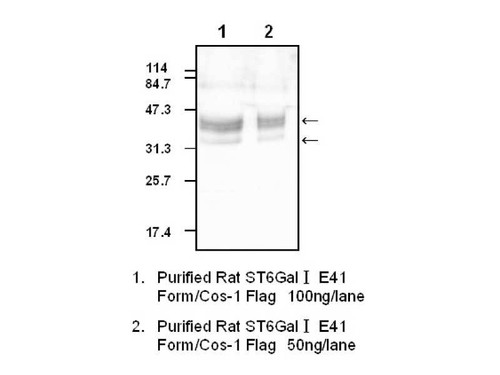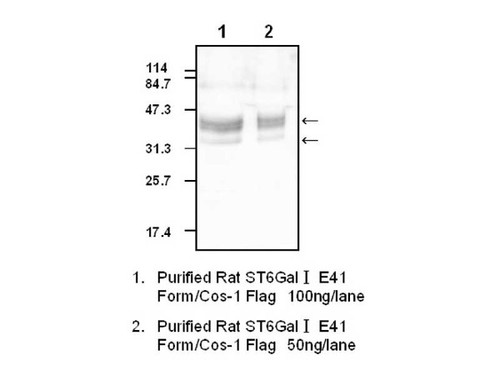The histopathological picture of Alzheimer’s disease is characterized by senile plaques and neurofibrillary tangles, and because the senile plaques form first, they are considered the initial lesion. Senile plaques are known to be formed by accumulation of β-amyloid peptide (Aβ). Aβ peptide is produced by the cleavage of amyloid precursor protein (APP) by two types of proteolytic enzymes. The first cleavage is performed by β-secretase (BACE1), and the second γ-secretase. It is thought that their inhibitors may be capable of serving as safe drugs for the treatment of Alzheimer’s disease. In recent years a glycosyltransferase involved in the biosynthesis of sugar chains (α2,6-sialyltransferase) has also been shown to be cleaved by BACE1. The cleavage site was identified at the same time, and as a result it was demonstrated that in humans it produces cleavage-type α2,6-sialyltransferase (E44 Form) and in rats it produces cleavage-type α2,6-sialyltransferase (E41 Form). For research use only, not for use in diagnostic procedures.
- application:
- WB
- Catalog number:
- 18985-S
- Datasheet:
- formulation:
- Lyophilized product from PBS containing 1 % BSA and 0.05 % NaN3
- immunogen:
- Synthetic peptide for the C-terminal part of α2, 6-sialyltransferase (the part common to human, mouse and rat)
- MSDS:
- notes:
- For research use only, not for use in diagnostic procedures.
The datasheet for this product (see above) is intended to serve as an example only. Please refer to the datasheet provided with the antibody for precise details. - Protocol:
- purification:
- Purified with antigen peptide
- size:
- 10 µg
- specificity:
- Reacts with Human, Mouse, Rat α2, 6-sialyltransferase
- storage:
- Lyophilized product, 5 years at 2 - 8 °C; Solution, 2 years at -20 °C
- Host:
- Rabbit
- Additional info:







